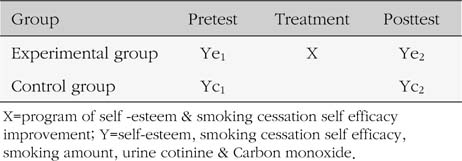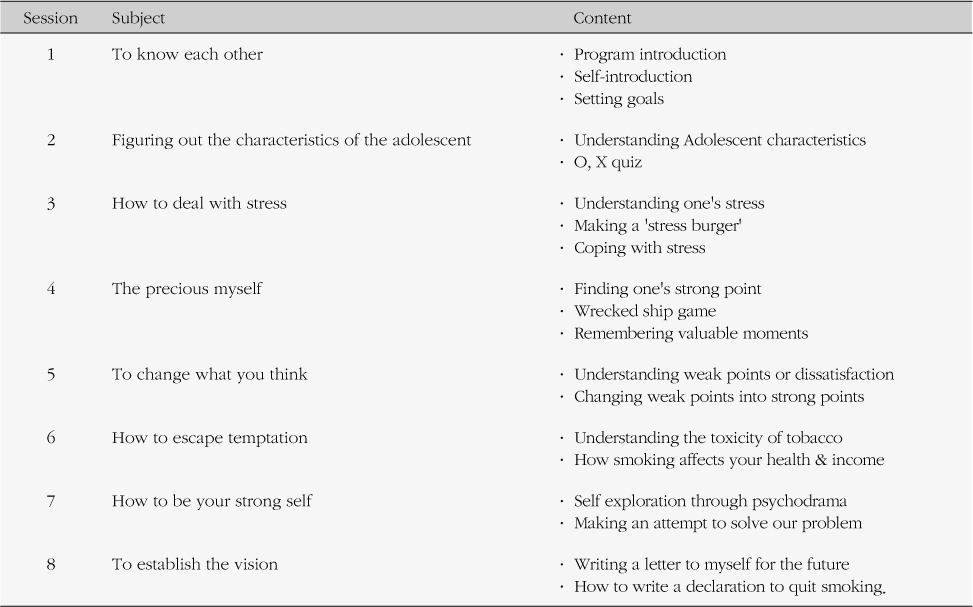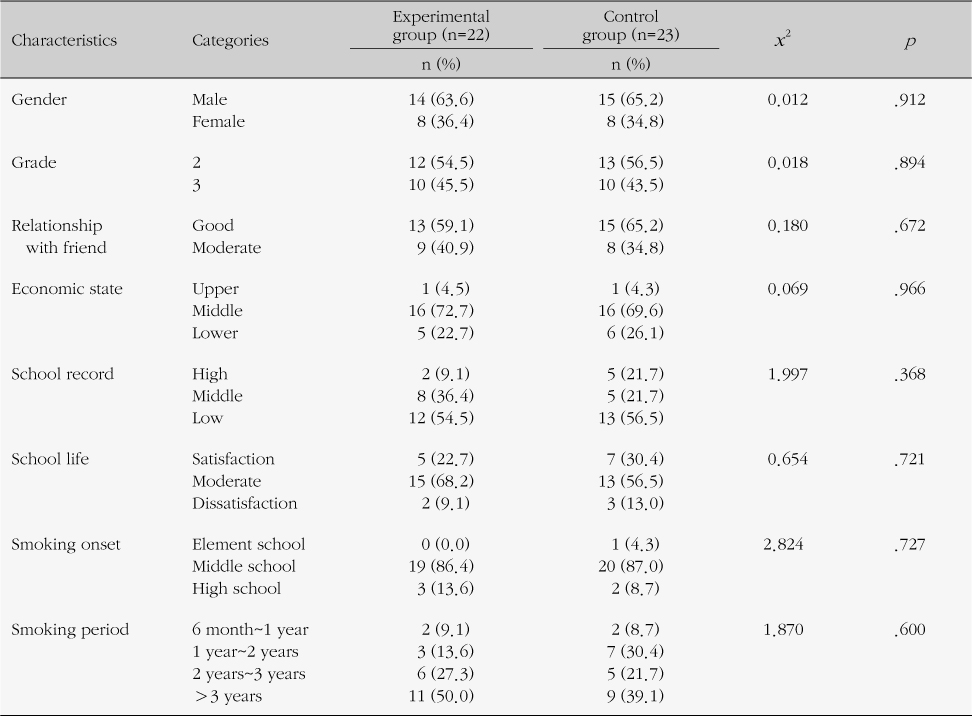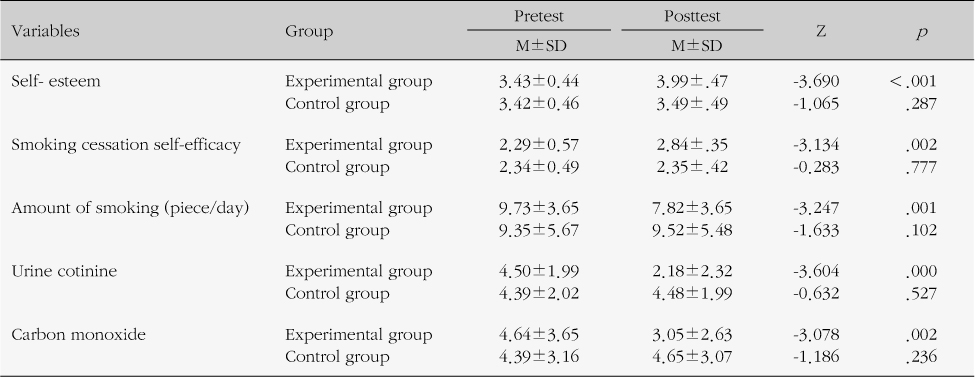Articles
- Page Path
- HOME > J Korean Acad Community Health Nurs > Volume 22(2); 2011 > Article
-
Original Article
- The Effects of a Self-esteem and Smoking Cessation Self-efficiency Improvement Program on Smoking High School Students
- Young Sook Kim
-
Journal of Korean Academy of Community Health Nursing 2014;22(2):121-130.
DOI: https://doi.org/10.12799/jkachn.2011.22.2.121
Published online: April 4, 2014
Full-time Lecturer, Department of Nursing, Uiduk University, Korea.
• Received: February 17, 2011 • Revised: May 18, 2011 • Accepted: May 26, 2011
© 2011 Korean Academy of Community Health Nursing
This is an Open Access article distributed under the terms of the Creative Commons Attribution Non-Commercial License (http://creativecommons.org/licenses/by-nc/3.0/) which permits unrestricted non-commercial use, distribution, and reproduction in any medium, provided the original work is properly cited.
- 636 Views
- 0 Download
- 7 Crossref
Abstract
-
Purpose
- The purpose of this study is to understand the effects of a program to improve self-esteem and smoking cessation self-efficiency on smoking high school students' self-esteem, smoking cessation self-efficiency, amount of smoking, cotinine in urine, and carbon monoxide while exhalation.
-
Methods
- This research was conducted as a quasi-experimental pretest and posttest control and experimental group methodological comparison study. The subjects were 45 smoking high school students (Exp.=22, Cont.=23) in U City. Data were collected from October 19 to December 7, 2010, and analyzed using the SPSS/WIN 12.0 program by frequency, Mann-Whitney test, means, standard deviations, and Willcoxon signed rank test.
-
Results
- After the treatment, those belonging to the experimental group showed significantly increased self-esteem and smoking cessation self-efficacy and also showed decreased amount of smoking, cotinine in urine, and carbon monoxide while exhalation compared to the control group.
-
Conclusion
- The self-esteem and smoking cessation self-efficacy improvement program was effective in improving self-esteem and smoking cessation self-efficacy and in diminishing the amount of smoking, cotinine in urine and carbon monoxide while exhalation. Therefore, this program is recommended as a smoking cessation strategy for smoking adolescents.
- 1. Brady SS, Donenberg GR. Mechanisms linking violence exposure to health risk behavior in adolescence: Motivation to cope and sensation seeking. J Am Acad Child Adolesc Psychiatry. 2006;45:673–680. ArticlePubMed
- 2. Choi EY, Yang JK. Counseling on juvenile delinquency and drug abuse. Seoul: Hakjisa; 2005.
- 3. Choi WB. The analysis of factors affecting adolescents' smoking. Daejeon: Daejeon University; 2001. Unpublished master's thesis.
- 4. Choi YM. The effect of group ceramic art therapy for the self confidence and conviction in smoking adolescents. Iksan: Wonkwang University; 2010. Unpublished master's thesis.
- 5. Chung YI, Nam EW. Are you still smoking. Seoul: Gyechuk munhwasa; 2001.
- 6. Collins RL, Ellickson PL. Integrating four theories of adolescent smoking. Subst Use Misuse. 2004;39:179–209. ArticlePubMed
- 7. Ellis A. Reason and emotion in psychotherapy. Secaucus, NJ: Citadel; 1962.
- 8. Jang GH. The effect of the smoking cessation group counseling program on smoking cessation self efficacy among boys' vocational high school students. Daegu: Kyungpook National University; 2005. Unpublished master's thesis.
- 9. Jee YJ. The effects of smoking cessation program using self regulated learning strategy in middle school boys. Pusan: Kosin University; 2009. Unpublished master's thesis.
- 10. Jung BS. The study on the effect of cognitive-behavioral anti-smoking program for high school students. Pusan: Inje University; 2002. Unpublished doctoral dissertation.
- 11. Kang SY, Kim SN. School-based educational programs for anti-tobacco use at Busan middle and high schools. J Korean Soc Health Educ Promot. 2005;22(4):91–105.
- 12. Kim HO. A study on the smoking related social influence, refusal skill and nonsmoking related self-efficacy among adolescents. Korean J Child Health Nurs. 2003;9(3):237–249.
- 13. Kim HS, Kim HS. The Influence of Alcohol Drinking and Substance Abuse on Delinquent Behavior among Korean Adolescents. J Korean Neuropsychiatr Assoc. 2002;41(3):472–485.
- 14. Kim CH. The study on the adaptation and self esteem of returnee adolescents. Seoul: Seoul Womans University; 1995. Unpublished master's thesis.
- 15. Korean Association of Smoking and Health. Adolescent smoking rate: 2008 2008;09 19 Retrieved March 20, 2010. from http://www.kash.or.kr/user_new/pds_view.asp
- 16. Korean Association of Smoking and Health. Adult smoking rate: 2009 2009;12 02 Retrieved March 20, 2010. from http://www.kash.or.kr/user_new/pds_view.asp
- 17. Lee JH, Kang ES, Lee MH, Lee YE. The effect of self efficacy promotion smoking cessation program for middle school students. J Korean Community Nurs. 2001;12(3):716–731.
- 18. Lee HS. A study on evaluation of effects of juvenile smoking cessation program applied by transtheoretical model. Busan: Inje University; 2005. Unpublished master's thesis.
- 19. Lee KE. Analysis of anti smoking effect through YP anti smoking education program. Seoul: Myongji University; 2003. Unpublished master's thesis.
- 20. Ministry for Health, Welfare & Family Affairs. A guide of national smoking prevention and smoking cessation program in 2008 2008;02 21 Retrieved March 5, 2010. from http://www.mw.go.kr/front/sch/search.jsp
- 21. Oh YM. The effects of cognitive behavior smoking cessation program and nicotine patch on smoking, stress coping strategies and self efficacy of high school student. Jeonju: Chonbuk National University; 2003. Unpublished master's thesis.
- 22. Park YH. A study about self-esteem, anxiety and depression of smoking adolescent. Daejeon: Chungnam National University; 2001. Unpublished master's thesis.
- 23. Pavanello S, Clonfero E. Biomakers of gentotoxic risk and metabolic polymorphism. Med Lav. 2000;91(5):431–469. PubMed
- 24. Rosenberg M. Society and the adolescent self-image. Princeton, NJ: Princeton University Press; 1965.
- 25. Shin SR. The study on the development of a self regulatory efficacy promoting program and it's effect on adolescent smoking. Seoul: Ewha Womans University; 1999. Unpublished doctoral dissertation.
- 26. Shin YH. The effect of anti-smoking program for girl's middle school smokers. Seoul: Seoul Womans University; 2003. Unpublished master's thesis.
- 27. Parvizy S, Nikbahkt A, Pournaghash Tehrani S, Shahrokhi S. Adolescents' perspectives on addiction: Qualitative study. Nurs Health Sci. 2005;7:192–198. ArticlePubMed
- 28. The American Cancer Society. Cancer facts and figures 2003 2003;Retrieved October 19, 2008. from http://www.cancer.org/downloads/STT/CAFF2003PWSecured.pdf
Figure & Data
References
Citations
Citations to this article as recorded by 

- Effectiveness of Integrated Change Model-based Smoking Cessation Program for High School Students
Hae Seon Lee, Su Hyun Kim
Journal of Korean Academy of Fundamentals of Nursing.2021; 28(2): 195. CrossRef - Effectiveness of a smoking cessation program on self-esteem, attitude, perception, and practice regarding control over smoking among male high school
Niyom Junnual, Chulaporn Sota, Anun Chaikoolvatana
Journal of Health Research.2019; 33(5): 366. CrossRef - Effects of a Strength Based I-Change Smoking Cessation Program for Smoking Middle School Boys
Jung Hee Kim, Yeon Hee Choi
Journal of Korean Academy of Nursing.2017; 47(2): 164. CrossRef - Structural Equation Modeling on Smoking Cessation Intention in Male Technical High School Students
Eun Su Do, Eunsuk Choi
Journal of Korean Academy of Nursing.2017; 47(2): 211. CrossRef - Relationship between self-efficacy and learning attitude according to smoking experience in the middle school students
Eun-Joo Son, Kyeung-Ae Jang
Journal of Korean society of Dental Hygiene.2015; 15(5): 805. CrossRef - Efficacy of Smoking Cessation and Prevention Programs by Intervention Methods: A Systematic Review of Published Studies in Korean Journals during Recent 3 Years
Hye Kyeong Kim, Ji Yeon Park, Eun Joo Kwon, Seung Hee Choi, Han-Ik Cho
Korean Journal of Health Education and Promotion.2013; 30(5): 61. CrossRef - Factors Influencing Nicotine Dependency among College Students Intending to Quit Smoking
Hea Shoon Lee, Mi Ryeong Song
Journal of Korean Academy of Fundamentals of Nursing.2013; 20(4): 429. CrossRef

 KACHN
KACHN





 PubReader
PubReader Cite
Cite


